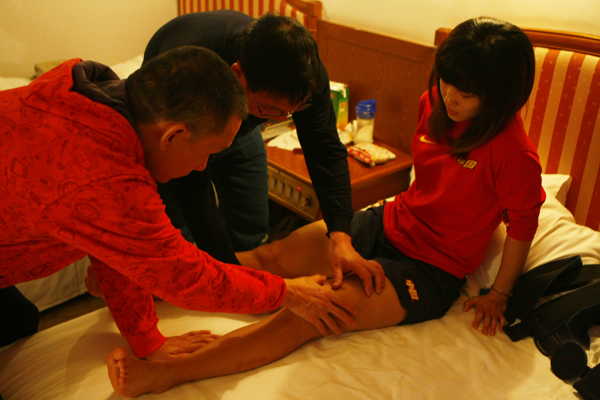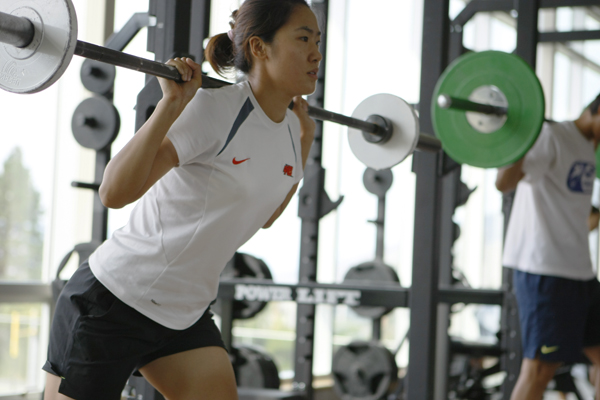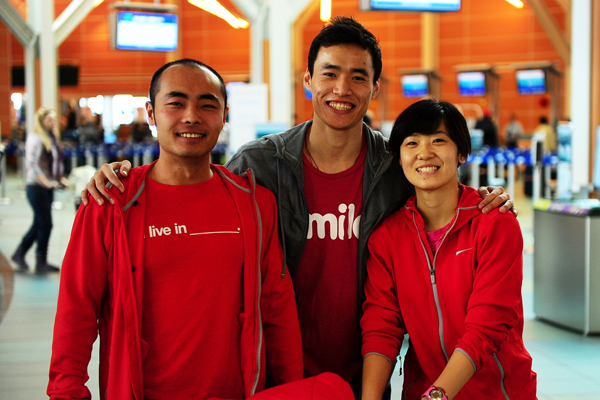Liu Qiu Hong2014-02-05 09:09:56 From:

● From pp. 19-20 of the third issue of Chinese Sports Coaches, 2013, dictated by Bob Chen
I joined the Chinese Sports Delegation, participated in preparations for three Summer Olympics and two Winter Olympics, and have provided targeted physical rehabilitation services for numerous outstanding athletes. Among them, the most memorable and exciting case happened three years ago. 21 days before the Vancouver Winter Olympics in January 2010, Liu Qiuhong, the main Chinese women’s short track speed skater fell unexpectedly during training, and instantly, the sharp skate cut the left side of her thigh laterally. The inner side of her quadriceps near the knee had a 20 cm long and 5 cm deep cut, almost reaching the thigh bone, and nearly 90% of the vastus mediallis fascicle was cut off. Because the wound was too long and too deep, the same night that she was admitted to the hospital, she was pushed into the operating room. They performed 6 layers of sutures, more than 250 stitches. This was my first time to encounter such severe trauma that was beyond the range of motion.
The Winter Olympics was about to start in 20 days. Liu Qiuhong, along with Wang Meng, both strong and experienced in 500 m and 1000 m speed skating, were considered double insurance for the gold medals. At just this moment Liu injured the crucial part : the left leg is the support leg for the short track speed skating event, and the quadriceps play an important role during skating. The brutal facts seemed to bring up an insoluble problem for the people who held the emergency meeting at the hospital. I went through a lot of domestic and overseas records, and found that no one had been able to recover and participate in training in such a short period of time. According to standard practice, the post-operative cast requires at least four weeks or more, which ensures the healing of the wound. During the discussion at the meeting, based on pathology and experience, the medical group had come to the same conclusion. Things seemed hopeless, and the leader and the team turned their hopeful eyes in my direction. Wang Meng said earnestly: “ Please do not give up on her. Even if there is a glimmer of hope, we support you!” To tell you the truth, I wasn’t sure at all at that time, but the coaches and the team’s ardent hopes urged me to take on the job, especially when the project manager said, “whether or not you are successful, the spirit of never giving up would be a great sense of inspiration for the entire team.” That’s when I took full responsibility for Liu Qiuhong’s rehabilitation plan and its execution, and experienced an unprecedented “battle.”
Cast was off after Discharged from the Hospital the Next Day
Four days after the operation, when Liu Qiuhong, sitting in a wheelchair, returned to the Capital Gymnasium quarters, we began the comprehensive “battle” of the rehabilitation. At that time, the biggest problem before us was that due to too many surgical suture stitches, under the skin of Liu’s injured part, there was congestion and adhesion, the internal and external areas of the wounds becoming hard and bruised, which would have had highly adverse effects on the healing recovery of the wounds, muscle and joint flexibility and activity, and so on. Due to this reason, we boldly took her cast off two days after she was discharged from the hospital, and used various methods of Chinese medicine to reduce swelling and dispel blood stasis. Our methods were: every other day we drew blood from the tip of one of her ears and everyday from five of her toes. Later on, we also applied this method closely above the wound, which was the poorest spot for metabolism; the congested blood drawn from here appeared a blackish color. The traditional Chinese physician of the medical group also used electric acupuncture therapy at the same time, which had the effectiveness of promoting blood circulation to dispel blood stasis.
At the same time, we used focused ultrasound treatment, a modern method of rehabilitation, for over an hour at each session, to put the energy 5 cm deep into the muscles, helping to soften the blood clots, accelerate partial absorption function, improve muscle flexibility, and increase the healing speed of the deep wound. Soon, we saw the effects. Liu Qiuhong’s wounded swollen leg was 5 cm thicker than the other one before, and after three days, the circumference of both her legs was almost the same.
Physical Training Starts from Bed
In order to maintain Liu Qiuhong’s physical quality, from the very first day after being discharged from the hospital, we broke the routine, and started a variety of physical training on her. The first week of training was conducted in her dormitory room, or even in her bed. Cardio exercises, land swimming, upper limbs and waist exercises, bench press, one-legged squats with bungee cord, etc., were all targeted and practical training arrangements, and upon reaching maximum strength, Liu Qiuhong’s heart rate reached 200 beats per minute. She had shown a very high physical quality, and her one-legged squat ability could be maintained for more than half an hour, with an average of 3 second to complete one, so that even her work out partner could not compete with her.
Seven days after being discharged from the hospital, Liu Qiuhong, who could barely walk, went to the workout room at the Capital Gymnasium. She started cycling, lying one-leg kicking, and a variety of core physical training. On the ninth day, she got on the ice. With her teammates’ assistance, she tried to skate slowly, but her injured leg could not squat down, and it had no feelings. We immediately placed therapeutic equipment under her foot, and used moderate vibration to stimulate the nerves of her numb leg. Then, we took her to the Spa Training Center at the State Sports General Administration, and put her on the water treadmill in the water, first for slow walking, then running when she no longer felt the pain. Besides, we let her do freestyle kicking motions. On the eleventh day, Liu’s wound scar had softened, and the swelling had vanished. She was able to run slowly, as well as jump in the water, and her injured leg could bend from 56 degrees to 80 degrees, 90 degrees, and eventually to 110 degrees, which was close to skating motion, and the skating speed had reached 80% of her best.
Flew to Compete 23 days after Injury
Liu Qiuhong once described her feeling at that time: “Every night I did not want to close my close to sleep for fear of lacking time, because I had to race against time.” In fact, the rehabilitation team shared her feelings. The team was watching her every tiny change incessantly, and except eating and sleeping, the complex physical rehabilitation training was carried out from 6:30 am to 10:00 pm. Meanwhile, we adjusted the rehabilitation program according to each situation, and did all we could to try to send her to the Olympic arena. On the 12th day, we heard good news: Li Guoping, the Medical chief of the Chinese Olympic Committee, organized a meeting with the medical experts, and conducted a comprehensive inspection on Liu Qiuhong’s recovery process, and made a careful assessment with her performance on the ice. Finally, the decision was made unanimously that Liu Qiuhong could participate in the Winter Olympics.
On February 12, I accompanied Liu Qiuhong and flew to Vancouver. Right after we arrived, she immediately went onto the skating rink, and her teammates who had arrived earlier were both surprised and delighted. You should know that not long ago when the team left for the Olympics, Liu Qiuhong was still on a cane waving good-bye to them with tears in everyone’s eyes, and now, she glided freely on the ice. The main coach Li Yan was more excited, and declared that a miracle was created. Even though for the purpose of protecting Liu Qiuhong’s health, the Chinese Olympic Team decided not let her take part in the competitions, that miraculous and indomitable spirit was a great inspiration to the whole team’s morale. The Chinese women’s short track speed skating team swept four gold metals at the Winter Olympics, and Wang Meng said tearfully, “although she did not compete, she contributed the same amount for the gold medals.”
60 days after the operation, Liu Qiuhong stepped onto the international arena and won the silver medal. Before this, one of the American male short track speed skaters who had participated in the Winter Olympics also suffered the same injury, but he could not resume normal training after 6 months of recovery. Liu Qiuhong’s recovery speed and the effectiveness of our treatment had given us a great deal of comfort. This is the repayment for our bold attempt and unremitting efforts.
Courageous Breakthrough, Continuous Innovation
This year, I was invited to New York to give a talk on innovation and practice of medical rehabilitation, and I told this story and received a great response from the audience. A senior doctor said, with a standing ovation: “This is the most touching story I have ever heard. It has not only displayed your highly responsible attitude to your patients, but also the innovative spirit of the doctor. There are many concepts and methods on human medicine needing to be constantly changed and improved, and only by doing so, can rehabilitation and medicine be developed to the highest level.”


Second, to venture audaciously does not mean being reckless and following like sheep, but to have a scientific and rational attitude, and use diligent working methods. Take Liu Qiuhong’s case for example. To recover in such a short time, using the rehabilitation methods either of traditional Chinese medicine or Western medicine alone would not be enough. After careful research, we finally adopted a combined physical rehabilitation method of Chinese and Western medical concepts. For example, a commonly used Western method for reducing inflammation and swelling is to compress with ice. Although this reduces the local inflammation, it also limits the metabolism of the injury. In this situation, using Chinese medicine to stimulate blood circulation and dispel blood stasis, combined with physical therapy and other modern methods would be more effective. The traditional Chinese doctor’s saying, “broken bones, 100 days” is actually not good for the healing process; on the contrary, it would affect the various functions of the body. Therefore, we used the modern methodology of Western rehabilitation, which suggests “early movement, sooner recovery,” taking the cast off Liu Qiuhong, and conducting exercises in bed, and this not only maintained her physical fitness, but also accelerated the pace of recovery of her injury.
Third, the spirit of the injured person’s willpower, the elimination of interference by the rehabilitation team, refusal to give up, and cooperation are the necessary conditions for recovery miracles. Because this type of short-term intensive rehabilitation process is an arduous “tug of war,” any tiny psychological withdrawal, weakened will and so on, could affect the final outcome, or even forfeit all the previous hard work. During this process, the strong-willed Liu Qiuhong, as well as the support from all aspects and the whole team’s united effort, were a guarantee of success.
Finally, we must pay full attention to the work of rehabilitation and physical ability. Outside our country, tasks related to rehabilitation and physical ability are carried out by two different professional experts. Due to China’s national conditions and the structures of its sports teams, at present we still lack people in this field, and so we have combined these two tasks to one. Years of practice have made me feel that in order to do this work well, we must have expertise in medicine, rehabilitation, physical training and other areas of knowledge and skill. We also need to be highly familiar with different types of sports, so that we will be able to formulate effective, personalized plans for patients. Furthermore, in the process of physical rehabilitation, we must break all prejudice, combine the advanced concepts and methods from both East and West, adopt each other’s strong points and overcome each other’s weakness. Liu Qiuhong’s rapid recovery is a typical case of such practices.


